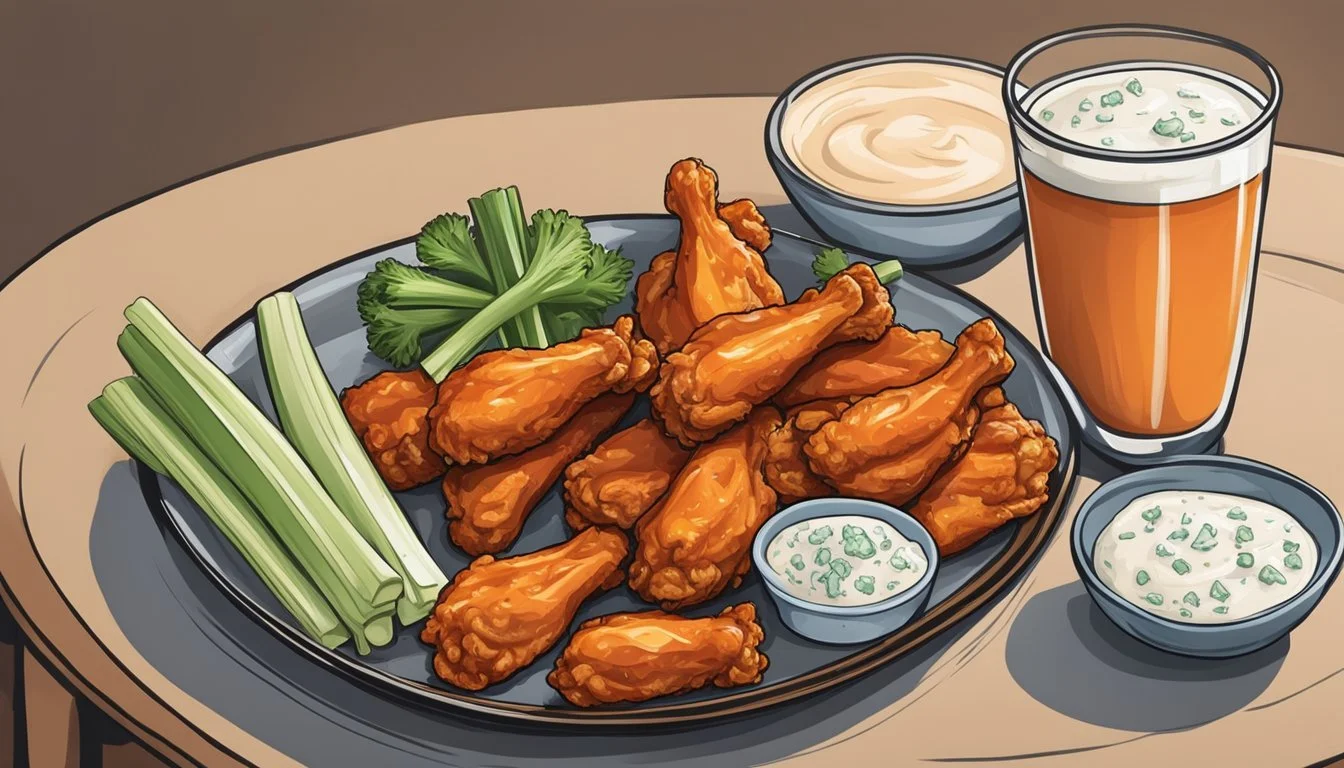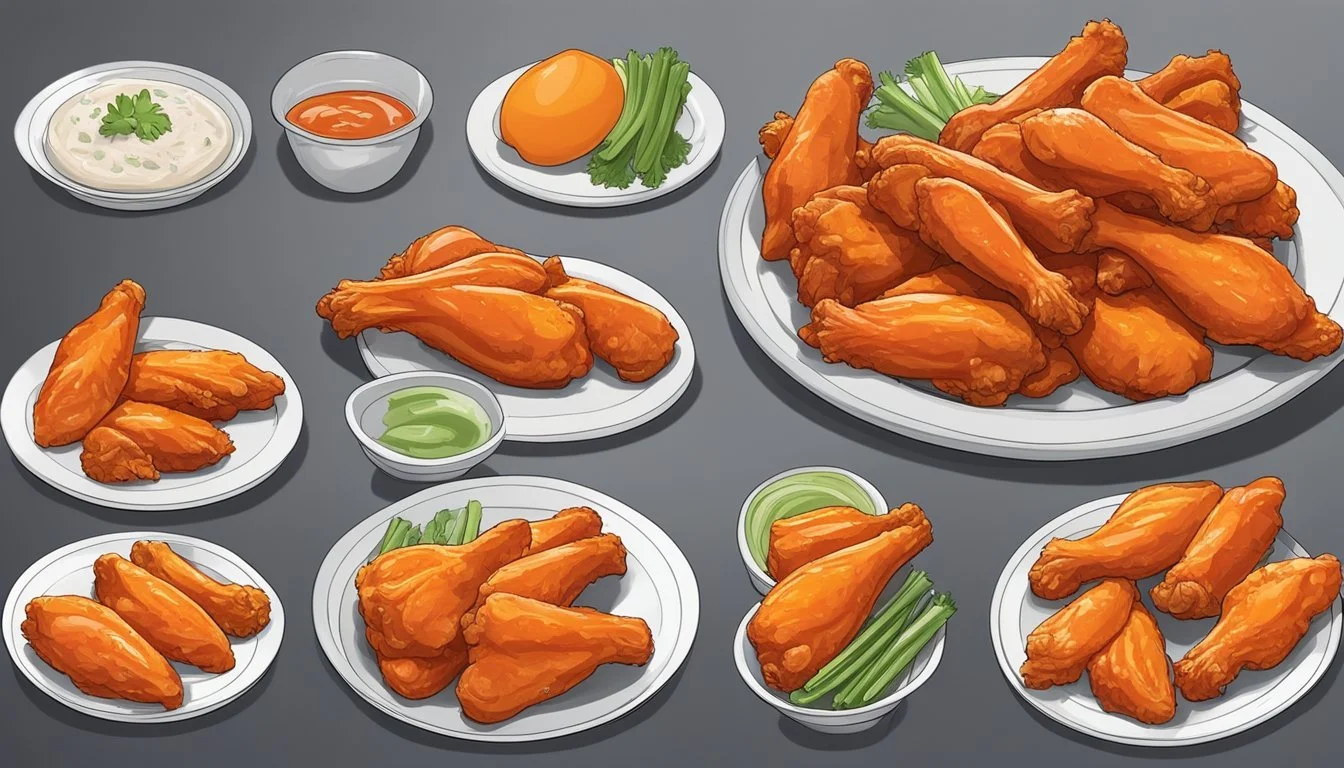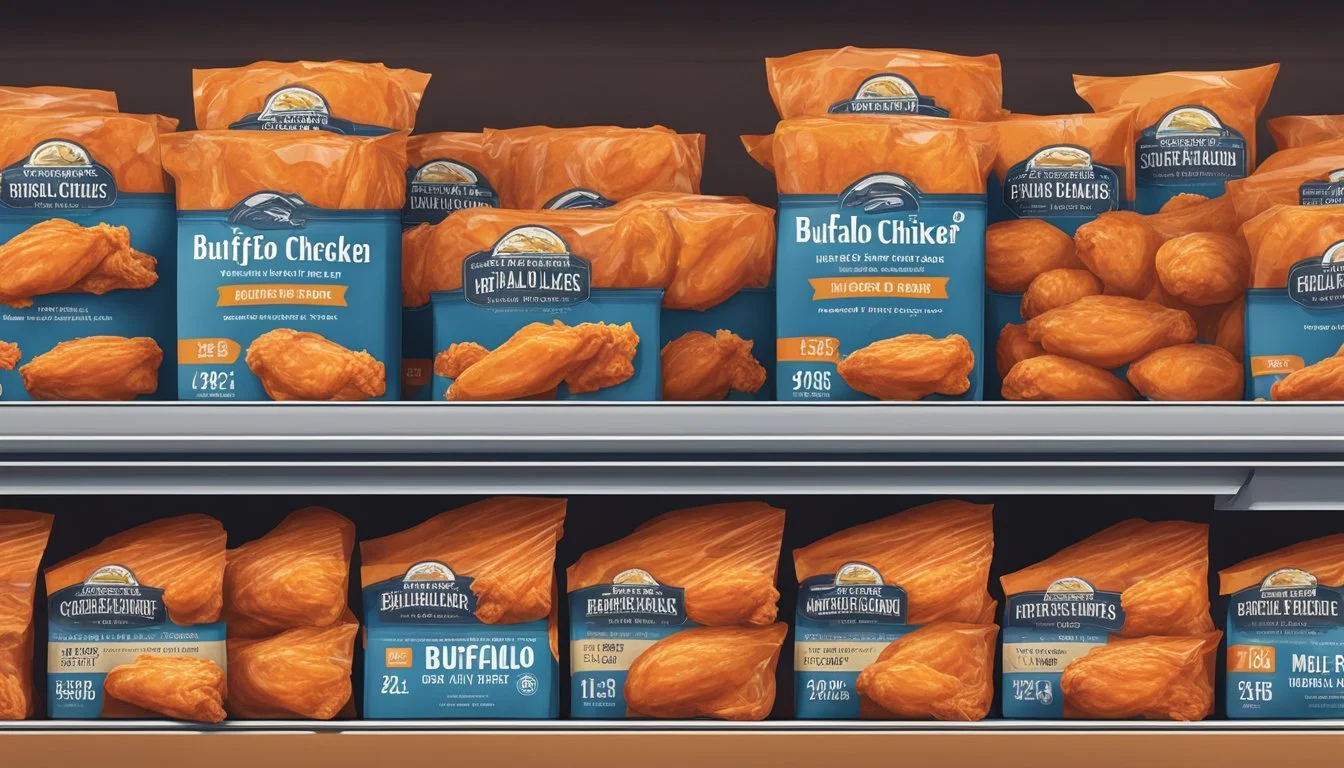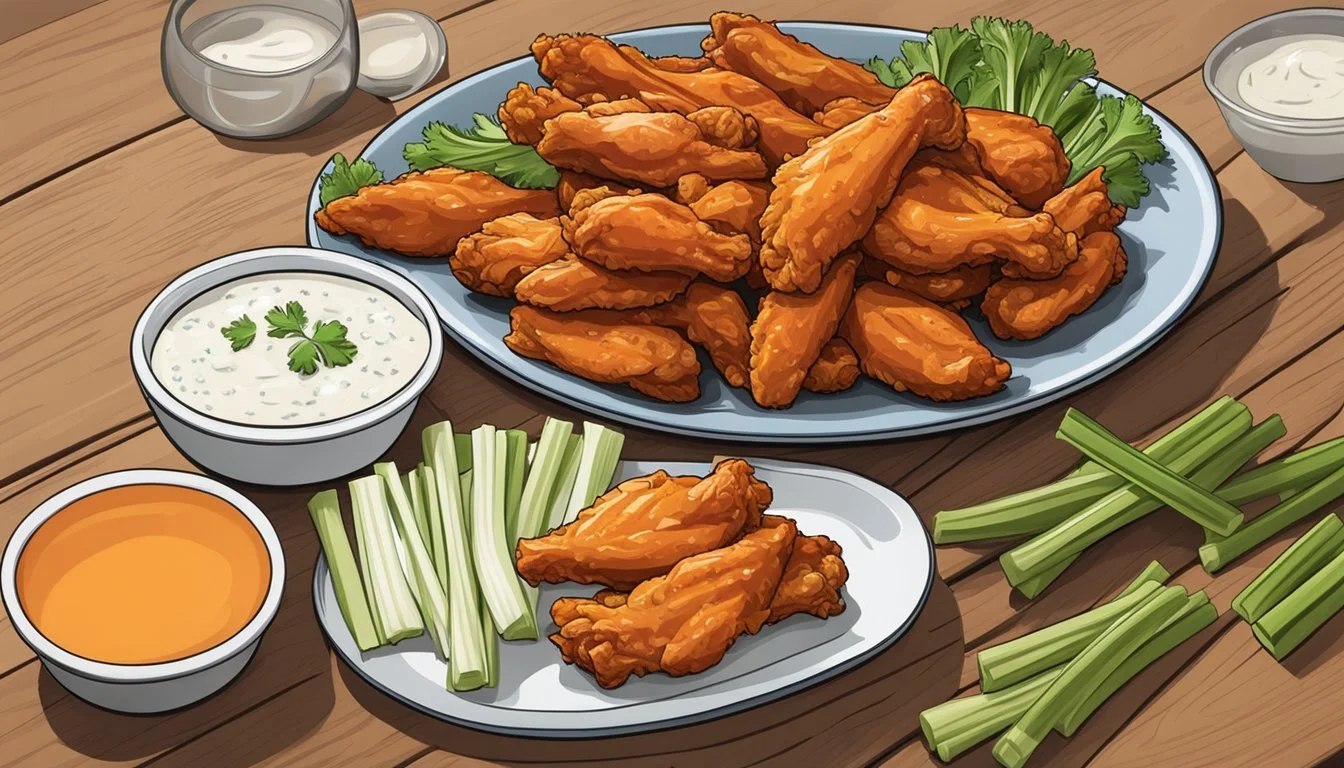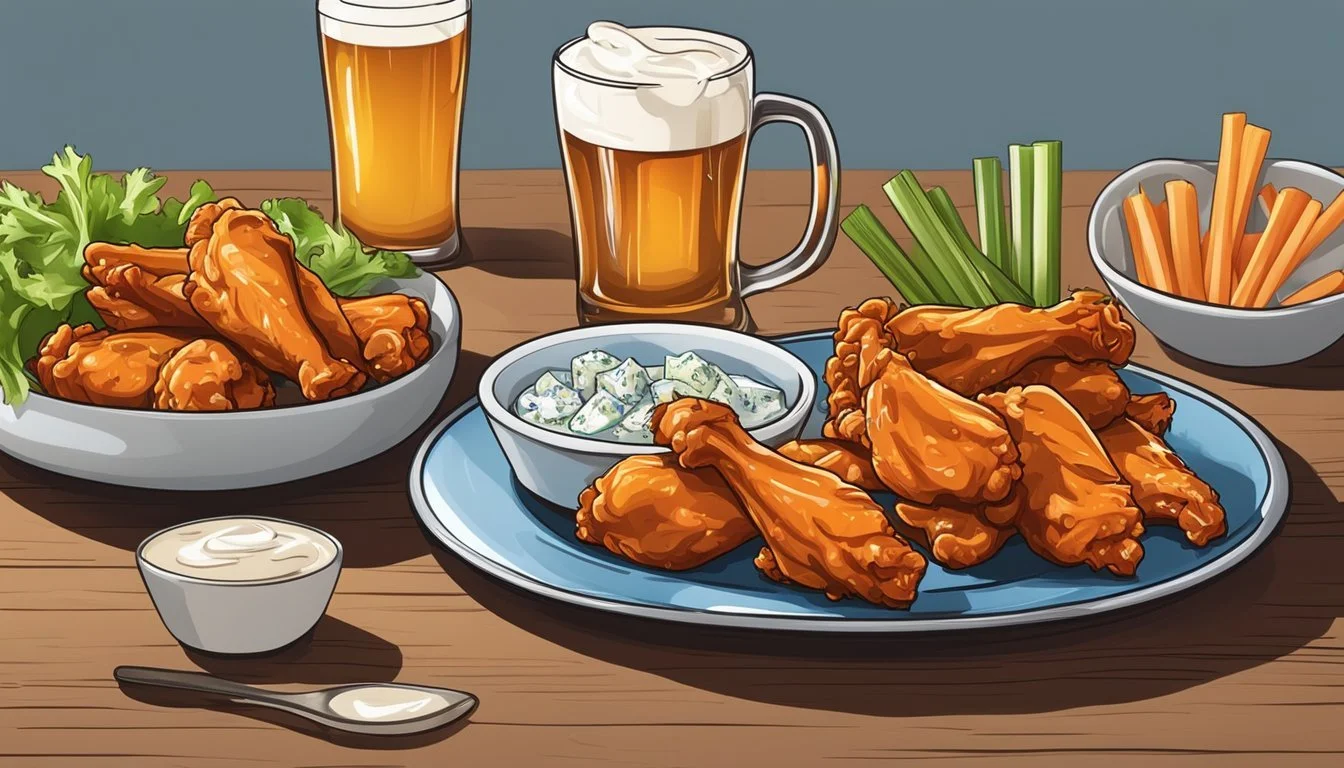How Long Do Buffalo Chicken Wings Last?
A Storage Guide
Buffalo chicken wings are a beloved snack for many, whether served at a sports bar or enjoyed at home. When it comes to storing these delicious wings, understanding their shelf life is essential to maintain quality and safety. Cooked buffalo chicken wings can last in the refrigerator for up to four days, as long as they are stored properly in an airtight container.
Refrigeration at a temperature below 41°F (5°C) is key to prolonging the freshness and preventing bacterial growth. The initial quality of the chicken and storage conditions also play significant roles in determining how long the wings will remain appetizing.
Eating leftover wings sooner rather than later ensures the best taste and texture, so aim to consume them within two days if possible. Proper storage practices will help you enjoy your buffalo wings safely and fully.
Buffalo Chicken Wings Overview
Buffalo chicken wings, known for their tangy and spicy flavor, have become a staple in American cuisine. They are typically deep-fried and coated in a mixture of hot sauce and butter.
History of Buffalo Wings
Buffalo wings originated in Buffalo, New York, in 1964. Teressa Bellissimo, the co-owner of Anchor Bar, is credited with creating the first batch. The wings were initially served as a late-night snack with celery and blue cheese dressing.
The simplicity and rich taste quickly gained popularity. Over the decades, buffalo wings became a common feature in bars and restaurants across the United States, especially during sports events.
The classic preparation involves frying the wings until crispy and tossing them in a sauce made of hot sauce and melted butter. The combination of heat and fat makes them immensely flavorful.
Essential Ingredients
Chicken Wings
The primary ingredient is chicken wings. They are typically separated into drumettes and flats for even cooking.
Buffalo Sauce
This sauce is a mixture of hot sauce and butter. The most traditional recipes use a 50/50 blend, but variations exist with added vinegar or garlic.
Seasoning
Before cooking, wings are often seasoned with salt, pepper, and sometimes additional spices like paprika or garlic powder to enhance the overall flavor.
Serving Tips
Buffalo wings are commonly served with celery sticks and a side of blue cheese or ranch dressing. This combination helps balance the spicy flavor of the wings.
Different cooking methods such as baking, grilling, or air frying can be used to prepare the wings, each affecting the final texture and taste.
Storage Fundamentals
Proper storage of buffalo chicken wings is crucial to maintaining their quality and preventing foodborne illnesses. Key considerations include how to store them both in the fridge and freezer to ensure freshness and safety.
Proper Storage Techniques
Buffalo chicken wings must be stored correctly to keep them fresh. Use an airtight container or a zip-top bag. These prevent the wings from being exposed to air and moisture, both of which can degrade quality.
Before storing, it's important to let the wings cool to room temperature. After cooling, they can be wrapped in plastic wrap or aluminum foil for an extra layer of protection before placing them in the airtight container. This helps prevent freezer burn if they’re going into the freezer.
If storing the wings for more than a few days, freezing is advisable. Frozen wings should be kept at a temperature below 0°F (-18°C) and can last up to six months. Labeling the containers with the date can help keep track of their storage time.
Refrigeration Best Practices
When refrigerating buffalo wings, ensure the fridge is set at or below 40°F (4°C). Wings stored in the fridge should be in an airtight container or tightly wrapped in plastic wrap or aluminum foil. Proper sealing minimizes exposure to air, preserving texture and flavor.
Cooked wings can remain in the fridge for 3-4 days. It’s essential to place them in the fridge within two hours of cooking to minimize the risk of bacteria growth. Reheating the wings to an internal temperature of 165°F (74°C) ensures they are safe to eat.
If serving wings at a party, remember that they should not sit out at room temperature for more than two hours. After this period, either refrigerate them immediately or discard them to maintain food safety.
Food Safety Considerations
When storing buffalo chicken wings, it is vital to recognize signs of spoilage and understand how to prevent foodborne illnesses. Proper storage practices are essential for ensuring the food remains safe to eat.
Recognizing Spoilage
Spoiled chicken wings can pose serious health risks. Look for signs such as an off or sour smell, slimy texture, or discoloration. If the wings have an unusual appearance or smell, it’s best to discard them.
Visual cues to recognize spoiled wings:
Color: Grayish or green hues indicate spoilage.
Texture: Sticky or slimy surfaces are a bad sign.
Smell: Any sour or foul odors mean the wings are no longer safe.
Cooked buffalo chicken wings generally last 3-4 days in the refrigerator. Always ensure they are stored in airtight containers and kept at or below 40°F to maximize their shelf life.
Preventing Foodborne Illnesses
Preventing foodborne illnesses starts with proper handling and storage. Buffalo chicken wings should be kept out of the "Danger Zone," a temperature range of 40°F to 140°F where harmful bacteria can rapidly multiply.
Keys to preventing foodborne illnesses:
Temperature control: Cook wings to an internal temperature of 165°F to kill bacteria.
Timely refrigeration: Refrigerate wings within 2 hours of cooking.
Avoid cross-contamination: Use separate utensils and cutting boards for raw and cooked chicken components.
The USDA recommends storing cooked wings in the fridge for up to 4 days. By following these guidelines, the risk of food poisoning can be significantly reduced, ensuring you enjoy your buffalo chicken wings safely.
Shelf Life Explained
Understanding the shelf life of buffalo chicken wings helps ensure they stay fresh and safe to eat. Key points include the differences between fresh and frozen wings and identifying signs of aging or spoilage.
Fresh vs Frozen Chicken Wings
Fresh chicken wings typically last for 1-2 days in the refrigerator if kept under proper storage conditions, below 41°F (5°C). It's crucial to store them in an airtight container to prevent contamination.
Cooked chicken wings can last in the fridge for 3-4 days. Proper refrigeration helps maintain their quality and safety.
Freezing extends their shelf life significantly. Raw wings can be frozen for up to 9 months, and cooked wings for about 4-6 months. Ensure they are wrapped tightly to avoid freezer burn, which can impact taste and texture.
Identifying Signs of Aging
To assess if buffalo wings have gone bad, look for several telltale signs:
Smell: Unpleasant, sour, or off smells indicate spoilage.
Texture: Slimy or sticky textures mean they are no longer safe to eat.
Color: Discoloration, such as gray or greenish hues, suggests they should be discarded.
For frozen wings, check for ice crystals or freezer burn, which can affect quality. It is best to routinely check wings before consumption to ensure they remain fresh and safe.
Preparation for Consumption
Proper preparation ensures buffalo chicken wings are safe to eat and taste their best. It involves thawing the wings correctly and choosing suitable cooking methods, followed by serving tips to maintain their flavor and texture.
Thawing and Cooking Practices
Buffalo chicken wings should be thawed safely. If frozen, they can be defrosted by placing them in the refrigerator for 24 hours. For quicker thawing, submerge them in cold water, replacing the water every 30 minutes.
Avoid thawing at room temperature to prevent bacteria growth.
For cooking, there are several methods:
Oven baking: Preheat to 425°F. Bake wings on a baking sheet for 25-30 minutes until golden and crispy. Flip halfway through.
Frying: Heat oil in a deep fryer to 375°F. Fry wings in small batches until crispy, usually 8-10 minutes.
Air frying: Preheat air fryer to 360°F. Cook wings for 25-30 minutes, shaking the basket halfway.
Grilling: Preheat the grill to medium-high. Grill wings for 20-25 minutes, turning occasionally.
Serving Suggestions
Once cooked, toss the wings in your preferred buffalo sauce. Classic sauces include Frank's RedHot mixed with melted butter.
To serve:
Arrange on a platter with fresh celery and carrot sticks.
Include dipping sauces like ranch or blue cheese.
For a crispier texture, allow the wings to sit in the sauce for a minute before serving.
Serve them hot to enjoy the best texture and flavor.
Enhancing Flavor and Texture
To achieve the best flavor and texture in buffalo chicken wings, focus on the right combination of seasoning, marinades, and cooking methods. These elements work together to create crispy and flavorful wings that are a delight to eat.
Seasoning and Marinades
Using a well-balanced seasoning is crucial. Start with kosher salt, pepper, and baking powder to help crisp up the skin. These ingredients draw moisture out, leading to a superior crunch when baked.
For marinades, a mixture of hot sauce, melted butter, and a touch of honey offers a classic buffalo flavor. Blue cheese can be added to the marinade for a rich, tangy twist. Be sure to coat the wings evenly and let them sit for at least an hour to absorb maximum flavor.
Cooking Methods for Optimal Taste
Both baking and deep-frying can yield crispy buffalo wings, each with its own merits. Baking on a baking sheet lined with aluminum foil and a wire rack ensures even cooking. Preheat the oven to 425°F, and bake for about 45-50 minutes, turning halfway through to get that crispy exterior.
Deep-frying, on the other hand, involves cooking the wings in hot oil until golden and crisp. This method usually takes about 10-12 minutes until they reach the desired texture. Regardless of the method, use a whisk to properly mix your buffalo sauce before tossing the wings for an even coating.
Serve the wings with celery sticks and a side of blue cheese dressing for a complete experience. Proper seasoning, marination, and cooking techniques guarantee flavorful and crispy buffalo wings every time.
Accompaniments and Variations
Buffalo chicken wings can be enhanced with flavorful dips and dressings, and there are many variations to suit different tastes. Below, we'll highlight the popular accompaniments and alternative wing varieties.
Dips and Dressings
Buffalo wings are traditionally served with blue cheese dressing. This creamy dip complements the spiciness of the buffalo sauce, enhancing the overall flavor.
Ranch dressing is another popular option. Its creamy texture and subtle flavor make it a versatile dip for those who prefer a milder taste.
Celery and carrot sticks are classic sides. They add a fresh, crunchy texture that contrasts with the juicy wings.
Garlic powder and other seasonings can be mixed into dips for added flavor. Honey and vinegar can be blended to create a sweet and tangy dipping sauce.
For a heartier option, serve wings with a side of crispy potato wedges or an appetizer like spinach and artichoke dip.
Alternative Varieties of Wings
Buffalo wings aren't limited to the traditional buffalo sauce. Garlic parmesan wings offer a rich, savory alternative. Coated in unsalted butter, garlic, and parmesan cheese, these wings are a hit for those who prefer less heat.
Honey Sriracha wings create a sweet and spicy combination. Mixing honey with sriracha sauce offers a balanced flavor profile for those who enjoy a bit of sweetness with their spice.
For the barbecue lovers, wings can be tossed in BBQ sauce and grilled. This adds a smoky flavor that's perfect for game day gatherings.
Beer enthusiasts might enjoy wings with a beer-infused marinade. The alcohol helps to tenderize the meat while imparting a unique taste.
These variations ensure there's a wing for every palate, making buffalo wings a versatile and crowd-pleasing dish.
Best Practices for Leftovers
Proper handling of leftover buffalo chicken wings can maintain their quality and safety for consumption. Following the recommended reheating methods and exploring creative uses can ensure they stay moist and flavorful.
Reheating for Best Quality
Reheating leftover buffalo chicken wings should be done carefully to retain their texture. The oven or toaster oven is the best option for this. Preheat the oven to 350°F (175°C). Lay the wings on a baking sheet, preferably on a wire rack to promote even heating and crispiness. Heat them for 15-20 minutes or until they reach an internal temperature of 165°F (74°C). This method helps keep the wings crispy on the outside while retaining moisture inside.
Avoid microwaving as it can make the wings rubbery. If an oven is not available, a stovetop skillet can also reheat the wings with a bit of oil to maintain texture. For best results, cover the skillet with a lid to keep the wings juicy.
Creative Use of Leftover Wings
Leftover buffalo chicken wings can be repurposed into other meals. Shredded wing meat can be added to salads, turning them into a main course with a spicy twist. Mixing the meat with pasta, along with some cayenne pepper, cream, and cheese, can create a flavorful buffalo chicken pasta.
Another idea is to use the wings in tacos. Remove the meat from the bones, mix it with salsa, and fill soft tortillas. Adding toppings like lettuce, cheese, and sour cream can create a quick and tasty meal.
Incorporating leftover wings into a stir-fry can also be a delicious option. Combine the shredded meat with vegetables and a stir-fry sauce for a quick dinner. These methods not only prevent waste but also provide an opportunity to enjoy buffalo chicken wings in new and exciting ways.

